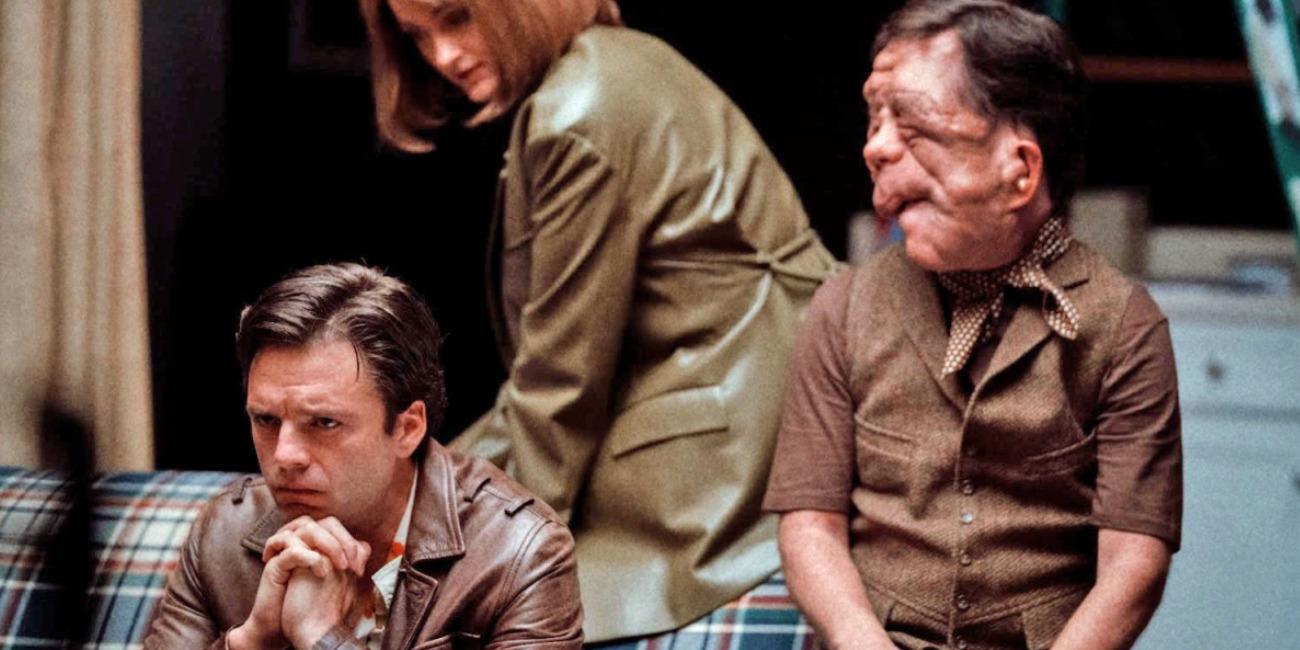‘A Different Man’ tells the story of a man with a facial disfiguration condition who perpetually feels like he’s on the outside looking in— but receives a bewildering chance to experience what life looks like on the other side. Aaron Schimberg’s genre-bending film centers around Edward Lemuel, an aspiring actor who has neurofibromatosis. Edward’s life is often down in the dumps, which he assumes to be a side-effect of his genetic disorder. Therefore, he feels his entire life change when he’s compelled to undergo a drastic cosmetic procedure that changes his appearance. As such, establishing his older self’s death, he becomes Guy Moratz, a conventionally attractive man with attractive prospects.
Nonetheless, Edward is forced to contemplate his life choices when he stumbles into an old friend, playwright Ingrid, who has written a play about him. Thus, Edward’s path crosses with Oswald, another man with neurofibromatosis who might just be the better fit for the role Edward was born to play. The film offers a nuanced take on the complexities of marginalization and media representation of people with visible disabilities. Consequently, Edward’s character becomes the central impetus for grounding this film in relevant social discussions.
A Different Man is a Fictional Story Based on Realistic Experiences
‘A Different Man’ retains fictitious origins as a work of Aaron Schimberg’s imagination, who is the writer and director of the project. Even so, despite not holding real-life counterparts in reality in terms of characters and events, the film and the creative process behind it sustain some inspiration in real life. Initially, Schimberg had multiple ideas for where the story could go, including a bizarre ‘Strange Case of Dr Jekyll and Mr Hyde’ situation. Alternatively, the inspiration behind the 2017 film ‘Wonder’ and how an interaction between a real kid with a disability and the book’s author compelled the latter to write the inciting novel also roused Schimberg’s creativity. In that case, the filmmaker essentially wanted to tell a story about a person who strongly believes a piece of art is about them.

Ultimately, although the former idea fell through, the latter became an influence on a part of Edward’s story. Still, the central starting point for the film came from Schimberg’s own experiences. The filmmaker — born with a cleft palate —is no stranger to examining the nuances of disability through his movies. Even though his work, especially the 2018 film ‘Chained For Life’ garnered good reviews, it was mostly overlooked by the mainstream public. Therefore, he wanted to tell a story that centers around disability while also attracting pop-cultural attention. Consequently, he arrived at the idea of casting a well-known, beloved actor.
Yet, Schimberg simultaneously held onto his belief in casting people with disabilities for roles of similar characters. Previously, this garnered some criticism, compelling some people to label his work as exploitative. “It seems to mean we just don’t want to deal with this issue,” he told Filmmaker Magazine when discussing the same situation. “And essentially, I thought, okay, well, I’ll try both. I’ll have a Hollywood actor in makeup, and I’ll have Adam Pearson (who plays Oswald). And I’ll have them go to war, both as characters but also as separate ideas.”

Therefore, by deciding to deal with this Catch-22 situation by flipping it on its head, Schimberg came up with the fictional story of ‘A Different Man.’ Thus, the film is essentially an exploration of disability and how it shapes the perception of one and those around them. Likewise, it also sheds some commentary on the various discussions around media representation of people with disabilities. It speaks about the lasting effects of social isolation that may have been caused by visible disability. Simultaneously, Oswald’s character showcases a different but equally attainable reality for people with disability.
Edward Lemuel is a Fictional Character that Mirrors the Appearance of a Real Actor
Much like the narrative of ‘A Different Man,’ protagonist Edward Lemuel also originated from fictional roots. His experiences and worldviews remain significantly influenced by Aaron Schimberg and his own reality. Additionally, his physical appearance before the surgery is modeled after Adam Pearson, a British actor who has Neurofibromatosis type 1. Reportedly, he lent his time to both Sebastian Stan and Makeup/Prosthetics Designer Michael Marino for them to better understand Edward’s character. Nonetheless, besides physical resemblance, Pearson shares no evident similarities with the character. As a result, Edward doesn’t retain a biographical parallel to any real-life individual.

However, Edward does portray universal experiences — particularly relevant to people who may deal with social “otherness” due to discrimination based on visible disability or otherwise. For the majority of the film, he has to deal with a life-altering change that essentially robs him of a part of his identity. As such, the film brings up nuanced and well-explored conversations surrounding themes of marginalization and representation. Still, it doesn’t equip the reality of an actual person to do so; instead, it fictionalizes a bizarre narrative around a fictional character.
Read More: A Different Man Ending, Explained


You must be logged in to post a comment.